I have repeatedly made the claim that AI chatbot traffic converts better than search engine traffic.
My thinking was that ChatGPT or Perplexity users go through evaluation and exploration cycles (remember the Messy Middle) faster and are closer to a purchase intent when they click on an outgoing link.*
But I couldn’t prove it at scale. Until now.
*Of course, there must be an impact of seeing brands mentioned in AI chatbots even without a link, but that’s not the focus of this study.
To prove this mental model right or wrong, Similarweb provided me with a large dataset of over 7 million referral sessions from ChatGPT, Copilot, Gemini, and Perplexity with Google Search across September, October, and November in the U.S.
The data focuses on transactional referral traffic. Due to its industry size, I notice a heavy bias toward ecommerce, but the data also covers conversions like software sign-ups.
Thanks to the Similarweb team, especially Lewis and Adelle, for supporting me with the data and your time.
Before jumping in, I want to point out a big caveat: AI chatbot referral traffic is still tiny compared to Google.
In How significant is AI chatbot traffic in B2B?, I found AI chatbot traffic to make up less than a percent of organic traffic today.
It’s growing at a rapid rate and could catch up over the next years, but reality is that it’s still small.
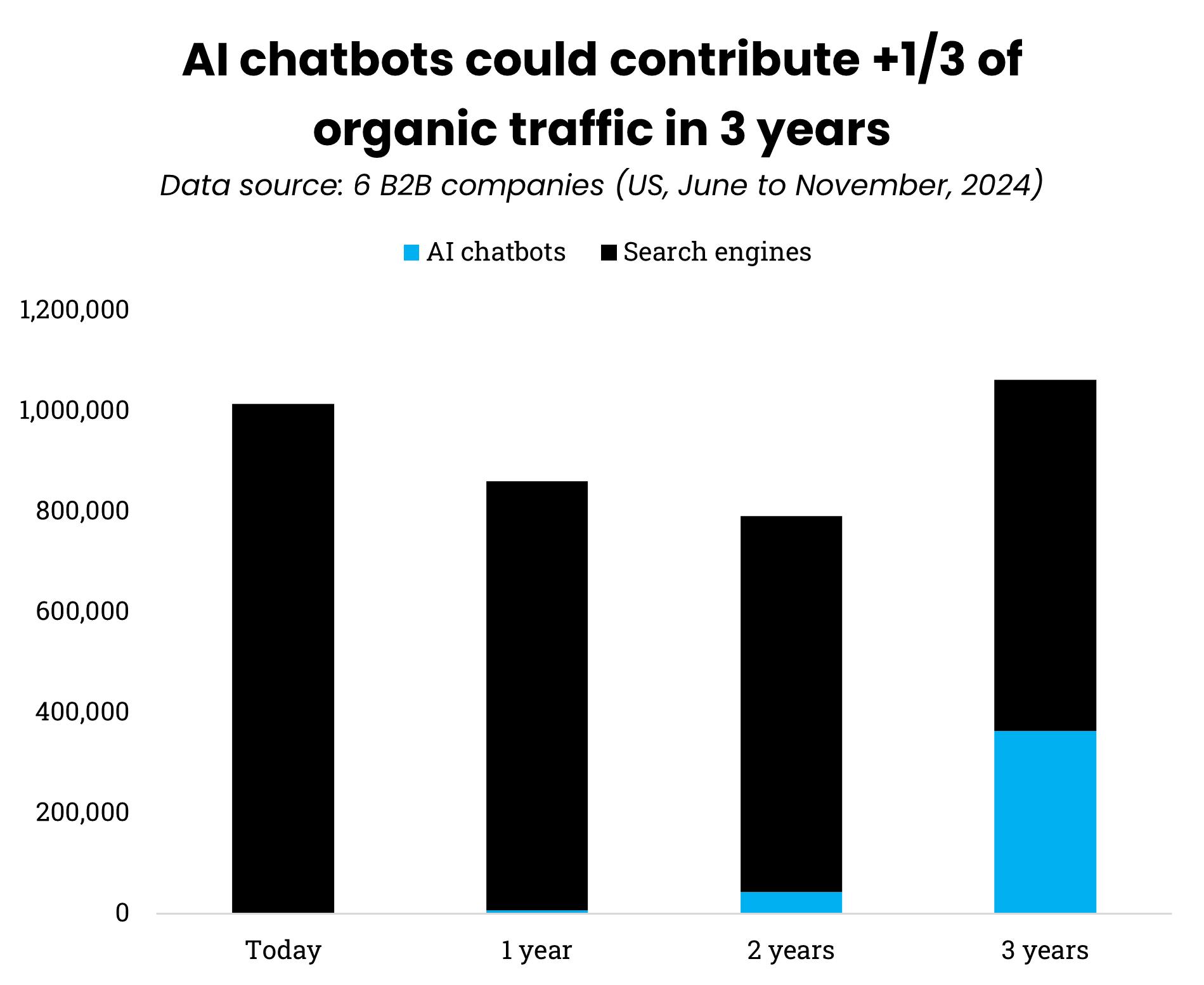 AI chatbot traffic (in SaaS) – Image Credit: Kevin Indig
AI chatbot traffic (in SaaS) – Image Credit: Kevin IndigSame ‘Ol, Same ‘Ol
I want to start with a look at the top 10 landing pages because it’s representative of how to think about the rest of the data in this study.
About 80% of (transactional) traffic to top the top 10 landing pages goes to ecommerce sites.
And, it’s mostly to the same players you already know from (Google) Search because AI chatbot answers use search results to ground (think: weight) their answers.
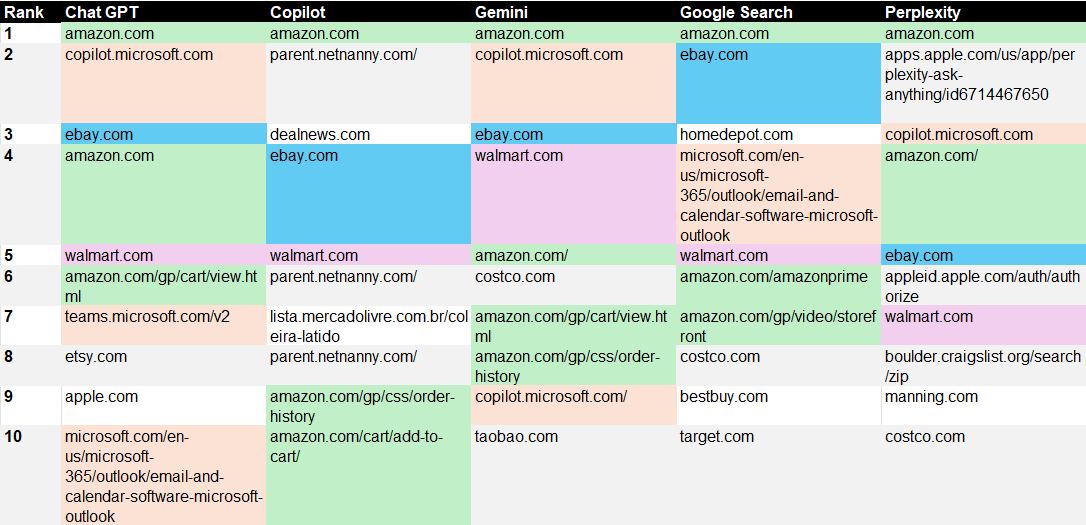 Top 10 landing pages by traffic from referrer (Image Credit: Kevin Indig)
Top 10 landing pages by traffic from referrer (Image Credit: Kevin Indig)Amazon, eBay, and Walmart dominate in Google Search just as much as in AI chatbots.
Microsoft appears surprisingly often in the top 10 landing pages, apparently because searchers are looking for software like Copilot or Teams.
Thinking one step further, if search results determine who’s visible in LLMs, the sites that dominate right now will also dominate the AI world.
I’m skeptical that this is how it will actually play out because users ask longer queries and have a conversational experience in AI chatbots, which should allow LLMs to develop their own “ranking factors.” What we’re seeing is the very first iteration.
AI Chatbot Traffic Is More Engaged
The big question I’m trying to answer is whether AI chatbot referrals convert better than search traffic.
I looked at two metrics to compare the traffic quality of each referral source: session duration and the number of page views per session.
High session duration in combination with a high number of (non-bounced) page views means users evaluate a product for longer and are more likely to buy when looking at transactional traffic.
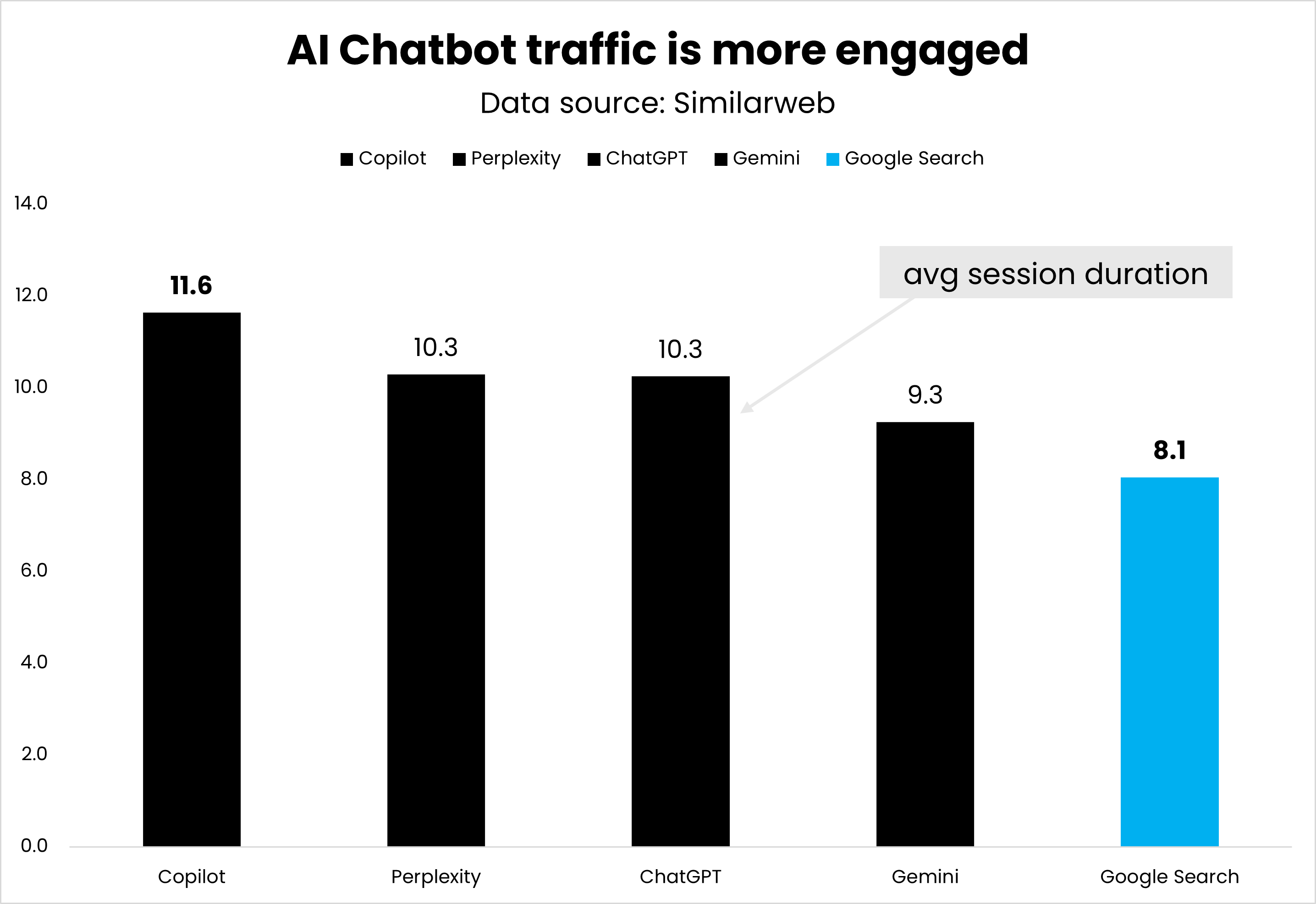 Avg session duration by referrer (Image Credit: Kevin Indig)
Avg session duration by referrer (Image Credit: Kevin Indig)The trend is crystal clear: AI chatbot referrals stay more than a minute longer than Google traffic.
The front runner is Copilot, with an average of 11.6 minutes per session. On average, AI chatbot traffic stays for 10.4 minutes, compared to Google’s 8.1 minutes.
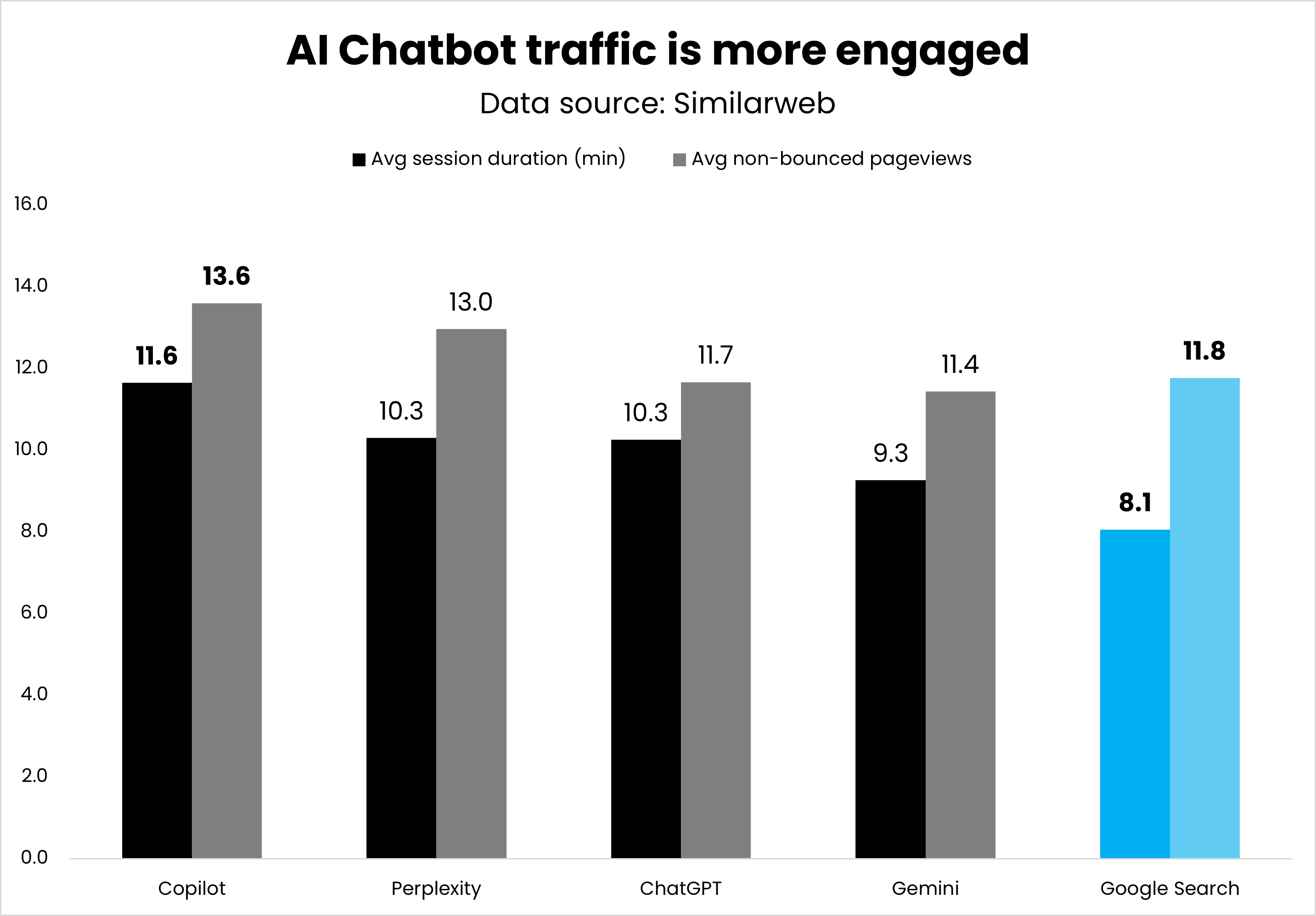 Avg session duration and number of non-bounced pageviews by referrer (Image Credit: Kevin Indig)
Avg session duration and number of non-bounced pageviews by referrer (Image Credit: Kevin Indig)To put session duration into perspective, I wanted to see if users who stay longer also visit more pages on a site. The answer is “yes.”
AI chatbot referrals visit 12.4 pages on average, compared to Google’s 11.8.
Again, more pageviews within the same session correlate with a higher chance of conversion when looking at transactional traffic, so this means AI chatbot traffic has a higher quality.
The average might not seem big, but luckily, Similarweb sent me data by month as well, so I was able to look at the trend over time.
I found that the number of non-bounced page views from Copilot and Perplexity grew faster than from Google between September and October: 15% and 22%, compared to Google’s 5%.
Gemini’s non-bounced page views shrunk by -11% over the same time and ChatGPT by -5%, which is reasonable given its rapid traffic growth.
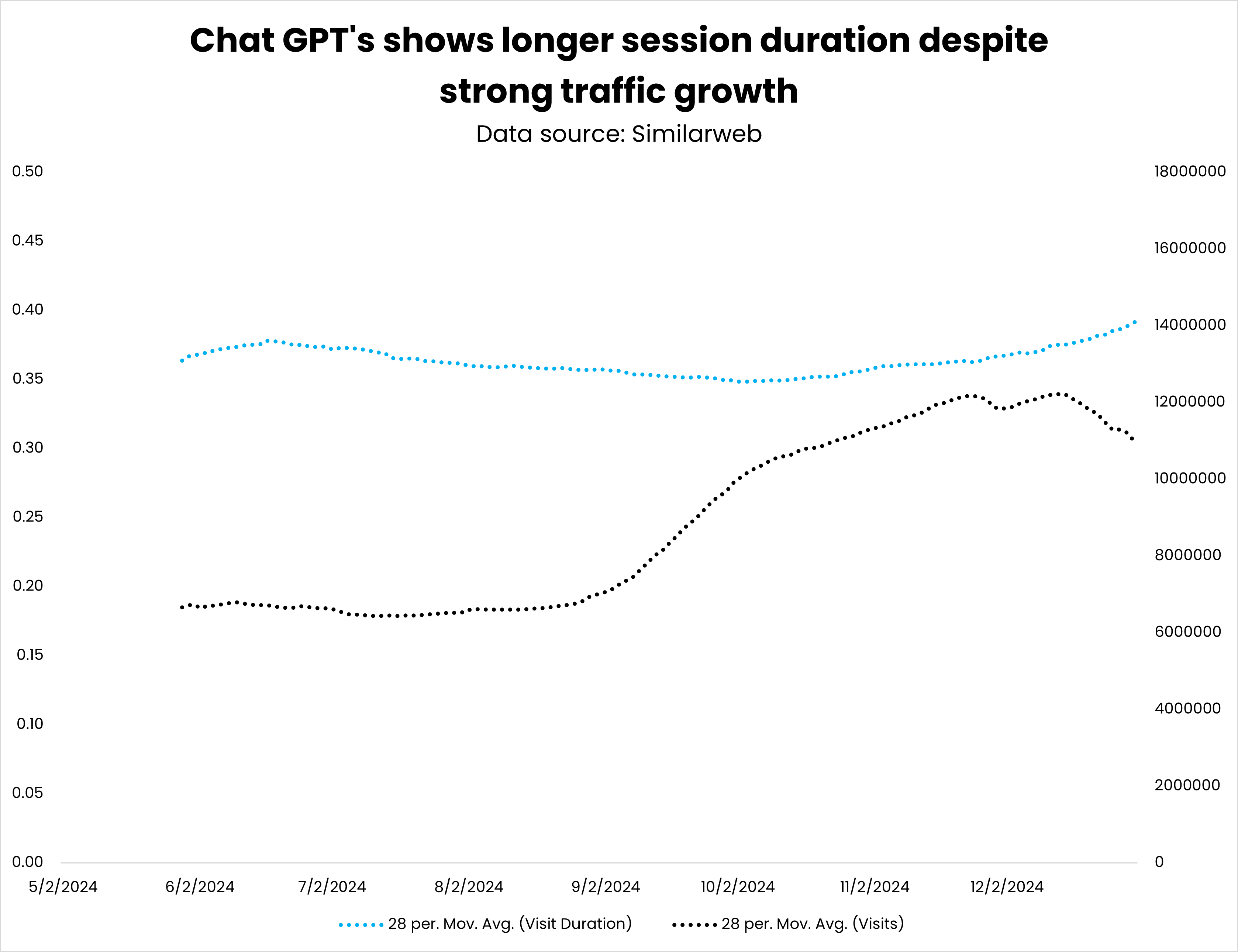 Session duration vs. visits on chatgpt.com (Image Credit: Kevin Indig)
Session duration vs. visits on chatgpt.com (Image Credit: Kevin Indig)In general, it’s impressive that ChatGPT’s session duration grows while traffic is exploding. It means that the models are getting better at answering questions while more people are using them.
Google’s session duration and traffic are flat in comparison, but with the context that Google is a matured channel and magnitudes larger than ChatGPT.
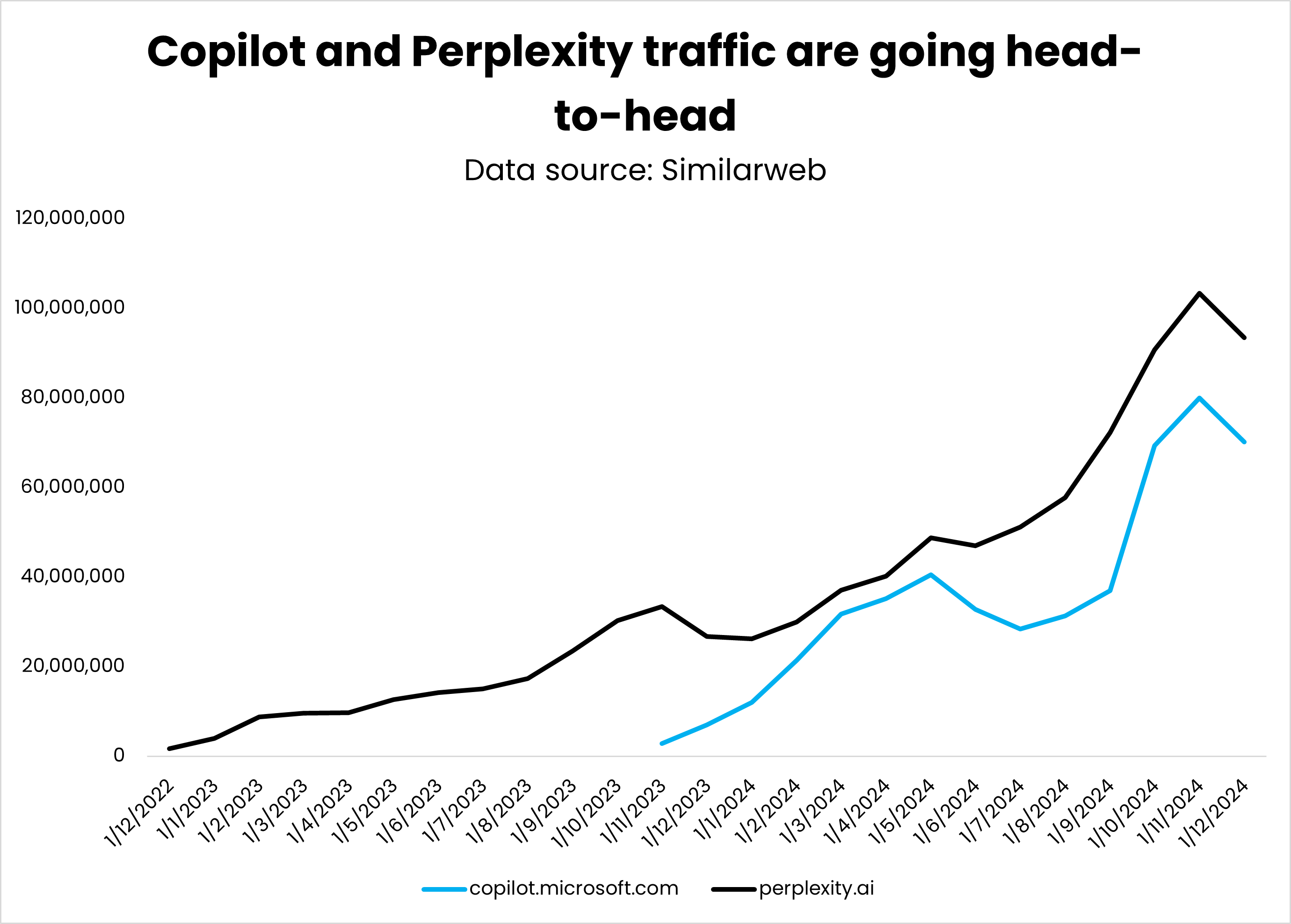 Total traffic to Copilot vs. Perplexity (Image Credit: Kevin Indig)
Total traffic to Copilot vs. Perplexity (Image Credit: Kevin Indig)To my surprise, Microsoft Copilot traffic shows better engagement than Perplexity, which has higher adoption and launched a specific ecommerce feature (Shop with Pro).
Copilot is not as far away from Perplexity as you might think (14 vs. 21 million visits in December 2024), and both saw big traffic gains in October 2024.
I explain this trend with Microsoft’s roll-out of Copilot on all of its devices and software products.
AI Chatbots Send More And Better Traffic To Homepages Than Google
To understand where AI chatbot referrals land and compare it to Google, I looked at folder depth as defined by the number of slashes in a URL after the domain name.
Higher folder depth = more folders in the URL = “deeper” in the site architecture.
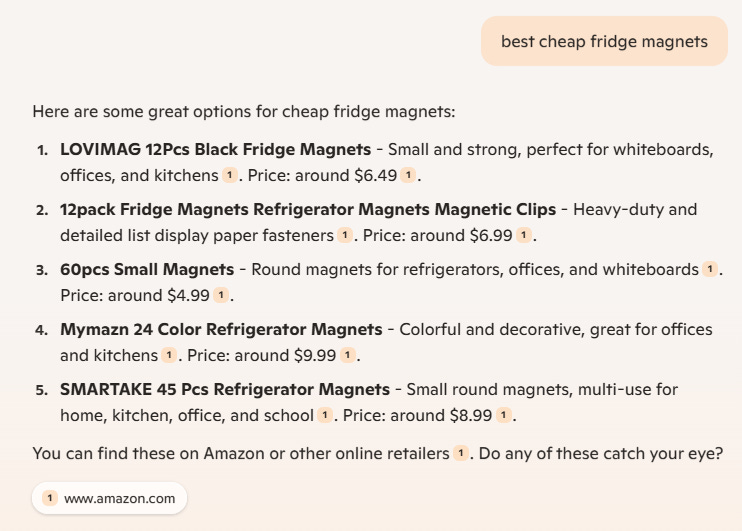 A search for a transactional keyword on Copilot (Image Credit: Kevin Indig)
A search for a transactional keyword on Copilot (Image Credit: Kevin Indig)For example, a search for “best cheap fridge magnets” in Copilot leads you to www.amazon.com/Best-Sellers-Refrigerator-Magnets/zgbs/kitchen/3737161?form=MG0AV3, which has a folder depth of 4.
Notice how Copilot references only Amazon results, even though Bing ranks Amazon No. 3 and No. 4 for the query.
The first (Printrunner) and second results (Uprinting) don’t allow you to buy fridge magnets but to design them. It seems that Copilot understands that.
My theory was that a higher folder depth means more traffic goes to specific products (ecommerce) and landing pages (B2B).
If users jump off of AI chatbots when they’re ready to convert, landing on pages with a higher folder depth should be a better result than a category page they have to explore again.
Keep in mind that most sites have a relatively flat architecture.
Consider the homepage level 0, a blog folder (/blog) or category page level 1, and products/sub-categories/landing pages on level 2 or 3. Of course, large retailers like Amazon could significantly skew the results because it has so many sub-categories.
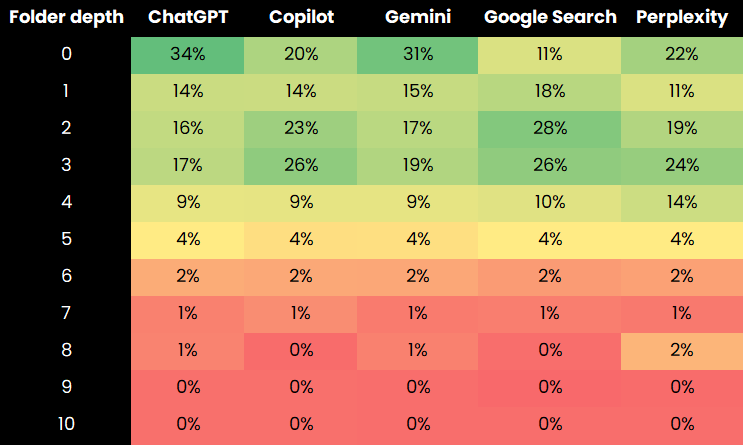 Folder depth of referral traffic (Image Credit: Kevin Indig)
Folder depth of referral traffic (Image Credit: Kevin Indig)Folder depth for referral traffic varies significantly between the difference referral sources, even among AI chatbots.
For example, ChatGPT sends over 50% more traffic to homepages than Copilot or Perplexity and over three times more than Google Search.
You should also note that only AI chatbots send referrals to a folder level of 8, which is the result of most sites not having as many levels, more so than preference.
I wonder if they’d send even more traffic deeper into websites if more sites had higher folder depth, which might not be ideal for (Google) Search but maybe for AI Search. We’ll need more data to answer this question.
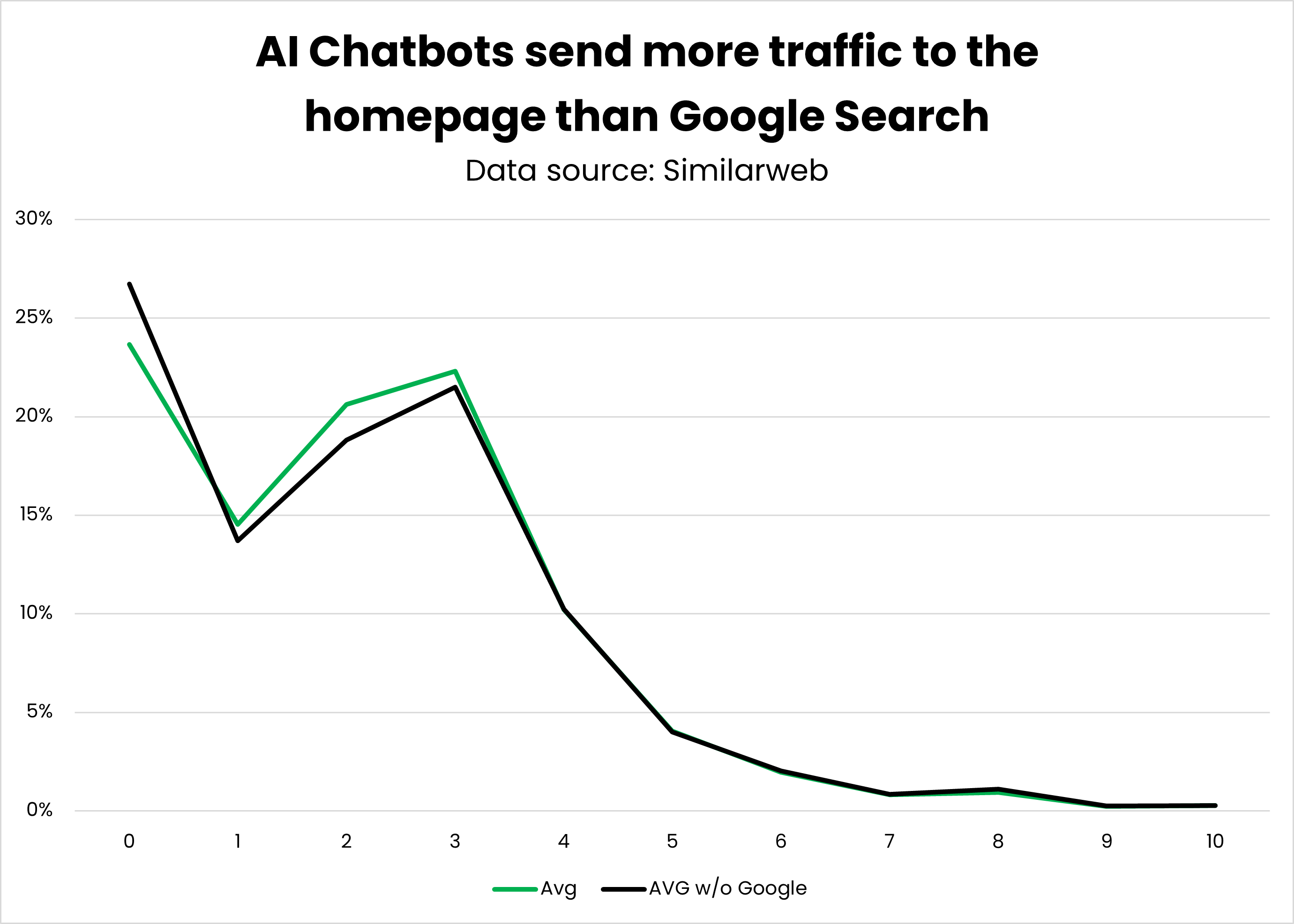 Avg folder depth with and without Google (Image Credit: Kevin Indig)
Avg folder depth with and without Google (Image Credit: Kevin Indig)On average, AI chatbots send more traffic to the homepage than Google, which sends more traffic to the second and third folder levels.
Perplexity sends traffic the deepest with an average folder depth of 2.45 compared to Gemini with 2.00 and Google Search with 2.33.
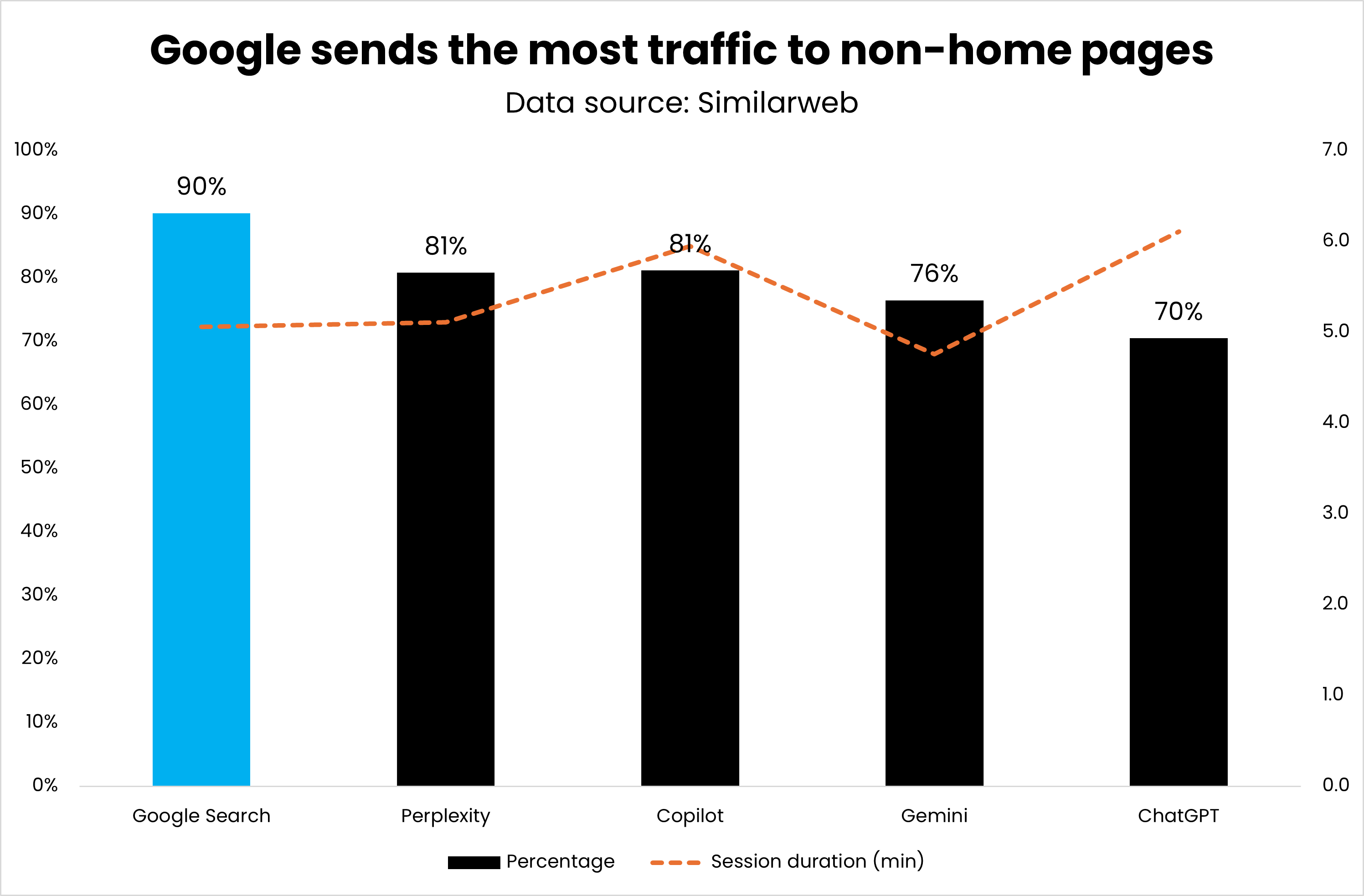 Percentage of traffic going to the homepage by referrer (Image Credit: Kevin Indig)
Percentage of traffic going to the homepage by referrer (Image Credit: Kevin Indig)ChatGPT sends most users to the homepage with 30%, compared to the other referral sources, while Google sends the least with 10%. The average for Gen AI referrals is 22%.
However, it works well for ChatGPT: Session duration is higher than Google’s for referrals to non-homepages, and both page views + session duration are higher for homepage referrals than for Google Search.
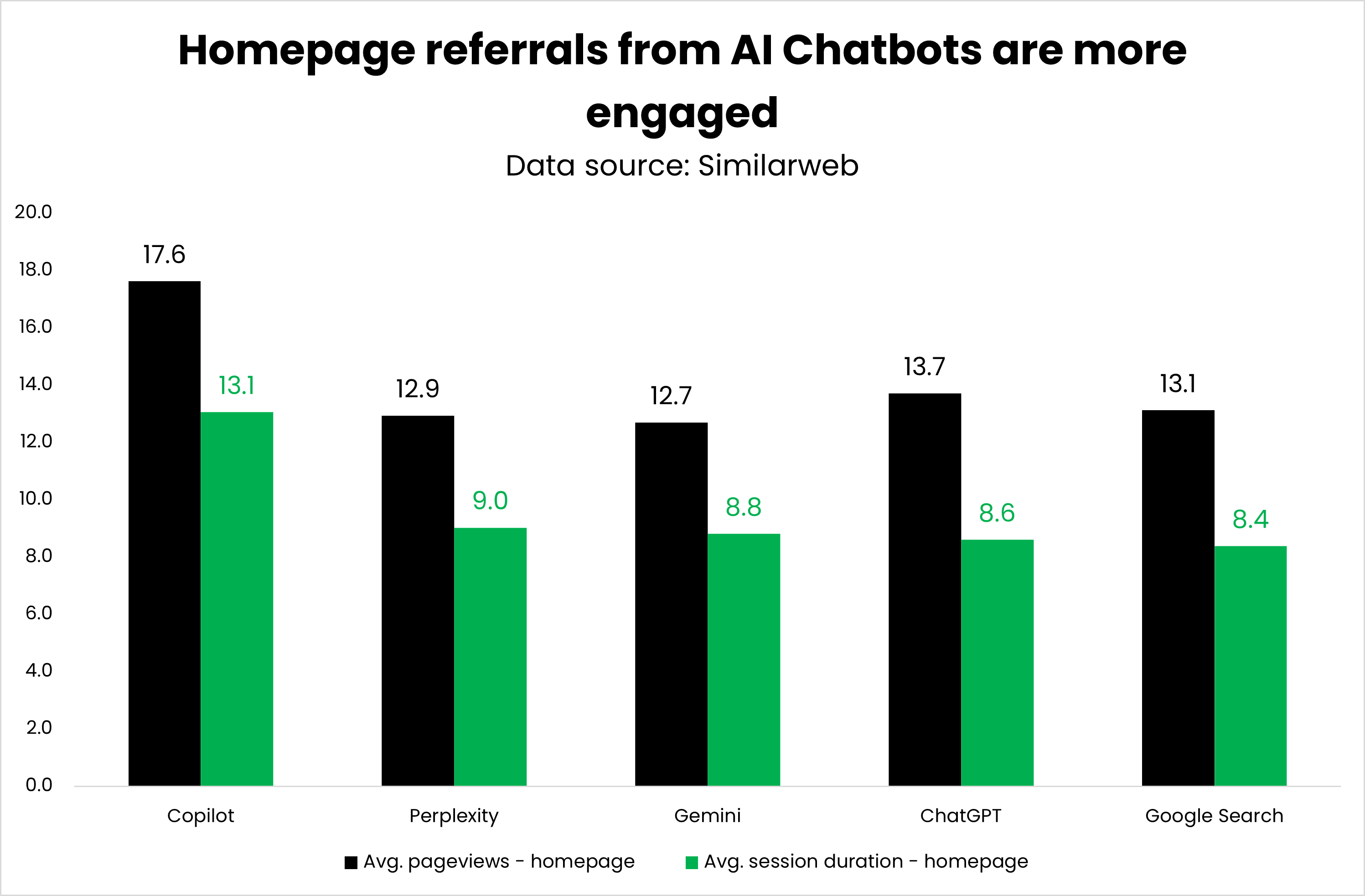 Avg. pageviews and session duration of homepage referral traffic (Image Credit: Kevin Indig)
Avg. pageviews and session duration of homepage referral traffic (Image Credit: Kevin Indig)The data indicates that homepages are more important in the “AI future” and that AI chatbots qualify users better before sending them out.
This is an important contrast to (Google) Search, where homepages are often not the best result except for brand searches.
To make this point even clearer, our knowledge about transactional traffic in the old Search world is that users are impatient.
As Adelle from Similarweb pointed out to me, AI seems to go counter to the age-old study of “every second a page loads faster, it converts more people.”
Instead, it pre-qualifies users before they visit a site, which leads to those users being happy to spend more time.
As a result, SEO specialists, UX designers, and product managers need to rethink the role of homepages in the user journey and site architecture.
Deeper Content Seems To Resonate Better
Next, I asked myself if we can see a relationship between the number of terms in a search query and where users land.
Unfortunately, we can only measure the number of terms per query for Google Search, so I’m making a big leap here.
I strongly assume AI chatbot users ask longer questions because the experience is more “conversational,” which Sundar Pichai, Alphabet’s CEO, confirmed on several earnings calls:
In the past year, we’ve answered billions of queries as part of our Search Generative Experience. People are using it to Search in entirely new ways, and asking new types of questions, longer and more complex queries, even searching with photos, and getting back the best the web has to offer.1
With the assumption that AI chatbots and results “prompt” users to search for longer queries, I compared the number of terms per query with session duration in relation to folder depth for Google Searches.
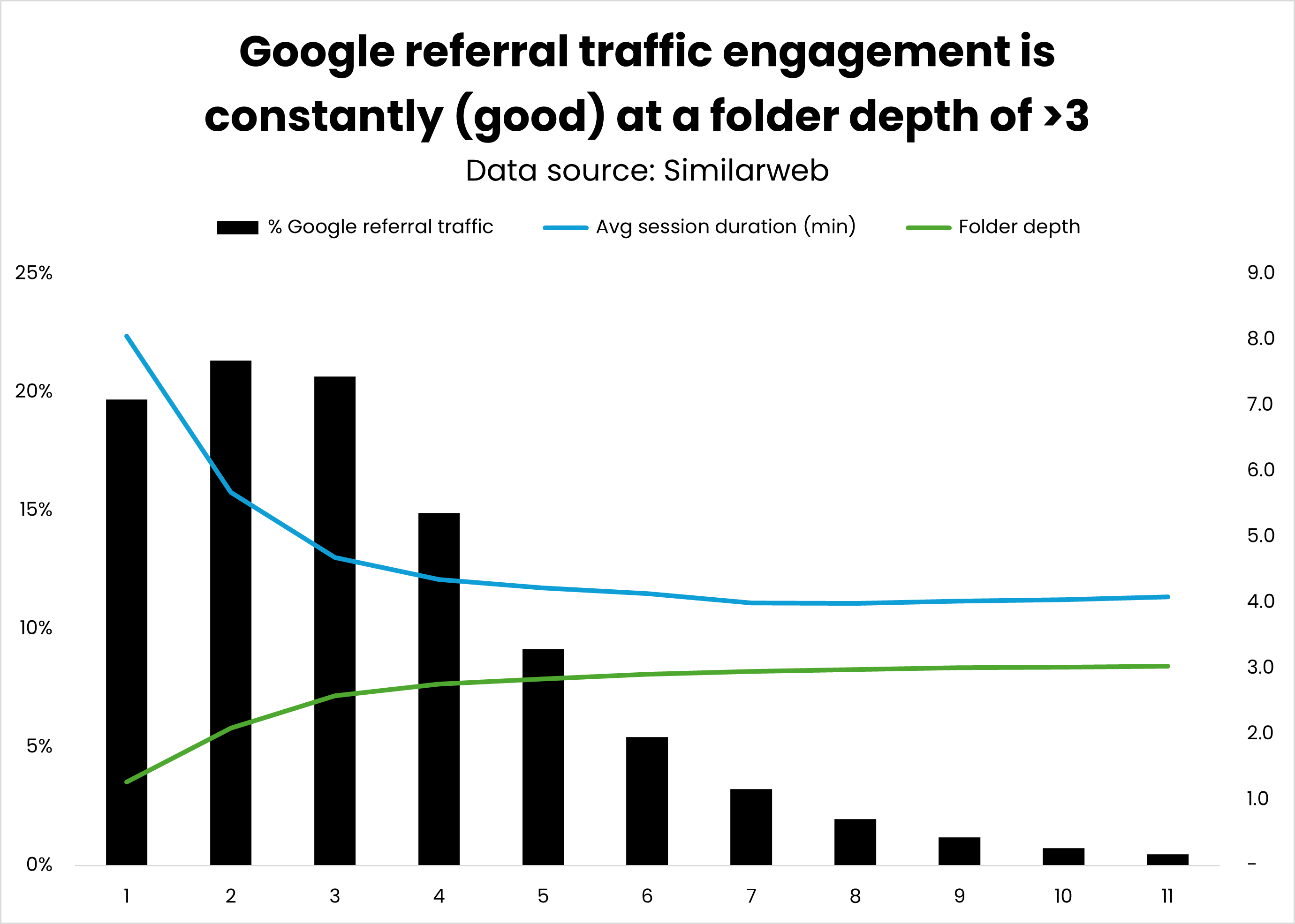 % traffic and session duration by folder depth (Image Credit: Kevin Indig)
% traffic and session duration by folder depth (Image Credit: Kevin Indig)Session duration shrinks until a folder depth of 4, which is when it flattens out.
In other words, users spend the same time on a site no matter whether they visit a page on level 4 or level 10.
That trend leads me to believe that they find what they’re looking for on deeper levels of a site (when coming from Search).
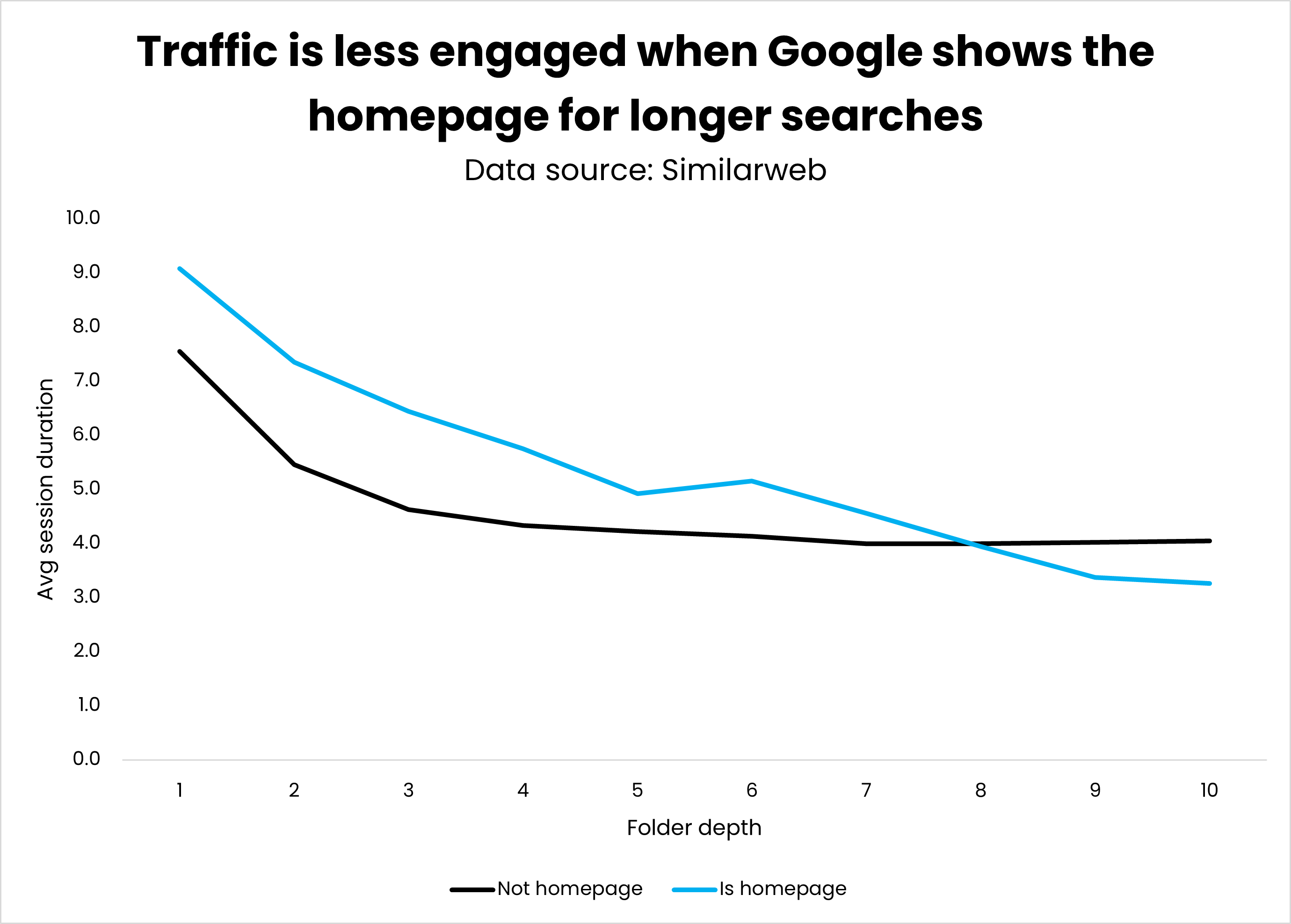 Google referral traffic to the homepage vs. other pages (Image Credit: Kevin Indig)
Google referral traffic to the homepage vs. other pages (Image Credit: Kevin Indig)The same is not true when we look at the number of terms for referral sessions to the homepage: Session duration doesn’t flatten out but keeps dropping with higher levels of folder depth.
So, how do we bring this back to AI chatbots? The data for Google Search raises the question of whether AI chatbot traffic would engage even better if less went to the homepage.
Since AI chatbots understand context so much better than (Google) Search, at least outside of AI Overviews, sending users to more specific pages should be a better experience.
The reason this isn’t happening yet could be that AI chatbots haven’t crawled enough of the web yet and that search functionality is still very nascent.
Conclusion: What It All Means
The adoption of AI chatbots is going incredibly well.
ChatGPT has over 300 million weekly users, Bing Chat seems to help the forever-second search engine finally gain market share, and we’ve hit a staggering 72% of companies that use AI in at least one business function.2
Over 7 million referral sessions from AI chatbots and Google Search reveal that:
- About 80% of transactional traffic goes to ecommerce sites, and the same players (Amazon, eBay, Walmart) dominate both in search and AI chatbots.
- AI chatbot referrals show higher engagement: They stay 2.3 minutes longer on average (10.4 vs. 8.1 minutes) and view more pages (12.4 vs. 11.8 pages on average).
- AI chatbots send significantly more traffic to homepages (22% average) compared to Google (10%) but still show higher engagement.
- Copilot and Perplexity showed faster growth in page views (15% and 22%) compared to Google (5%).
The big question is whether companies are willing to make an investment in AI chatbot visibility at this point with the potential reward of establishing themselves as a first-mover but at the cost of lower short-term impact.
The early results are promising, but a lot can change until AI as a “channel” reaches critical mass.
Boost your skills with Growth Memo’s weekly expert insights. Subscribe for free!
1 Google I/O 2024: An I/O for a new generation
2 ChatGPT now has over 300 million weekly users; Source; The state of AI in early 2024
Featured Image: Paulo Bobita/Search Engine Journal

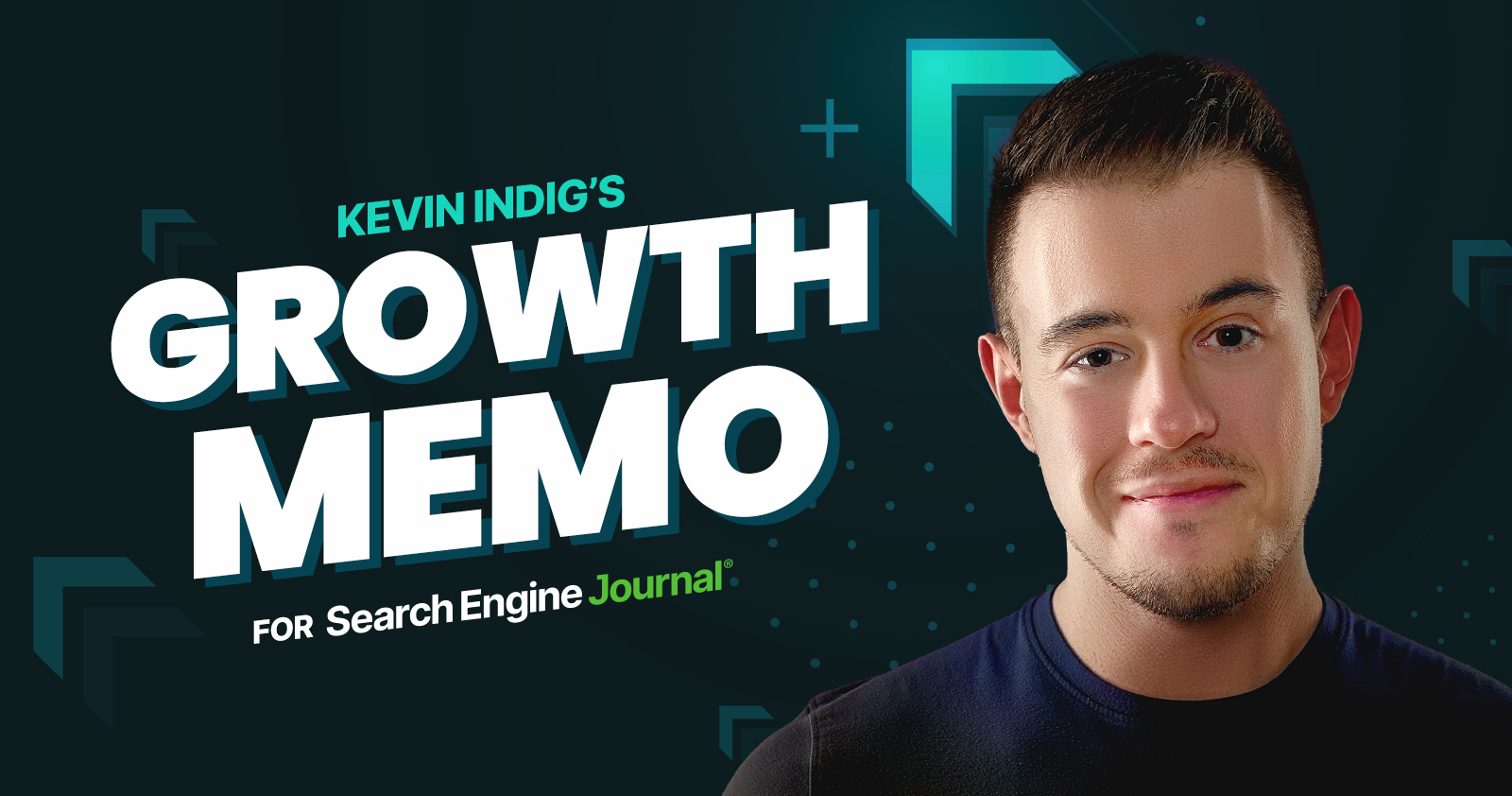



![[SEO, PPC & Attribution] Unlocking The Power Of Offline Marketing In A Digital World](https://www.searchenginejournal.com/wp-content/uploads/2025/03/sidebar1x-534.png)